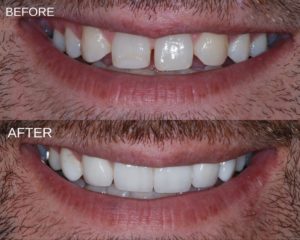Our natural teeth usually come with some slight imperfections that can be corrected with common dental or orthodontic interventions. The great news is that many times you don’t need to go to great lengths to fix minor problems.
By opting for spot treatment, you automatically avoid expensive and time-consuming orthodontic work. And in the long term, it will actually save you a lot of time and money. Spot treatment is one of the most affordable treatments that guarantees great results for minor problems such as gaps in your teeth.
Most importantly, know that you aren’t alone in this issue either. Many adults and teens have gaps or chips in their teeth which are easy to rectify with some minimally invasive cosmetic procedures like dental bonding.
This procedure can be done in one sitting and has little to no downtime, allowing you to get back to your normal life as soon as possible.
Gaps in adult teeth
A gap, also known as a diastema, can occur anywhere in your mouth but is most commonly found between your two front teeth. Most of the time this gap is minor and does not need any cosmetic intervention. However, in the instance where you find this area distracting, there are several options to correct it.
The most popular option these days seems to be either braces or Invisalign. Although these treatments are fantastic in that they do not require adding any foreign materials to your natural teeth, they are the most time-consuming methods. Other than that, you can also go with porcelain veneers. They are more invasive but have long-lasting results that look just like natural teeth.
Your third option, which is what we recommend, is dental bonding. It is the quickest and most affordable treatment of the three, and is perfect for “spot treatments” in the mouth where correction is needed.
What is dental bonding?
When your teeth need a simple, realistic-looking touch-up, dental bonding is the procedure for you.This is a relatively quick procedure that involves coating your teeth with a resin that adds to your existing tooth, concealing imperfections like stains, chips, cracks, and gaps. Dental bonding is particularly great in dealing with gaps because it closes the open space between teeth.
Dental bonding is done in four steps:
- First, your dentist will prep your selected teeth to receive the bonding adhesive by etching onto your tooth’s surface and adding a conditioning liquid.
- Then, your dentist will add the bonding resin to your teeth. It starts out as a putty but it can be shaped into the way you want it to look.
- When the shape is achieved, then your dentist will harden the bonding with ultraviolet light.
- Finally, the resin is polished to make it look as natural as possible while giving it a smooth and attractive texture.
What kind of gaps are good for dental bonding?
Not all gaps are good candidates for this procedure. It is very important to consult your dentist to assess your situation to see if dental bonding would be a good fit. For example, if you also have crowded or crooked teeth with an incorrect bite, you will need orthodontic work.
Essentially, if your only problem is a small gap, then your dentist will likely be able to help you without getting an orthodontist involved. This route will save you a lot of money and time, so it is advisable to go with dental bonding instead of investing more time and money than what is necessary.
Habits to quit after undergoing the procedure
If your dentist has cleared you for the procedure, you should be prepared to give up the following habits for optimal, long-lasting results:
- Smoking
- Biting on hard things like nails or hard candy
Since smoking can create some of the most stubborn tooth stains that even professionals have trouble eliminating, kicking that habit should be a priority.

Hard candies can chip your dental bonding because it is not as strong as natural teeth.
If you are a nail biter, you will definitely need to curb or eliminate the habit or else risk chipping your dental bonding.
You should also be mindful when you drink coffee and wine because these pigmented beverages can stain your teeth and bonding. Your bonding’s resin is porous, which means it can trap stains in its grooves.
How long does dental bonding last?
When your bonding is applied correctly and you take good care of your teeth at home, your bonding can last several years. It is very likely that you will need to repair your bonding periodically due to natural wear and tear. However, you can get the most out of each application by taking good care of your teeth with faithful at-home care and regular visits to the dentist.
If you have any questions about bonding for gaps in your teeth or any other dental issue, contact us! We are passionate about helping you achieve the beautiful smile you deserve.

